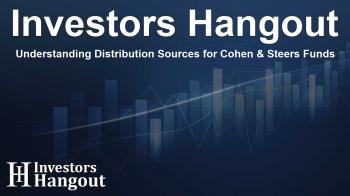Understanding Distribution Sources for Cohen & Steers Funds

Understanding Distribution Sources for Cohen & Steers Funds
Cohen & Steers REIT and Preferred and Income Fund, Inc. (NYSE: RNP) is informing shareholders about the upcoming distribution sources, which play a crucial role in investment decision-making. Regular updates are essential for shareholders to understand how their investments are performing and where their earnings are derived.
Insights into Managed Distribution Policy
In its ongoing commitment to delivering value, the Fund has established a managed distribution policy. This policy was put in place to ensure consistent monthly distributions to shareholders. By setting a fixed rate for distributions per share, the Fund can better navigate its long-term capital gains throughout the fiscal year. This policy enhances transparency while providing shareholders with vital information about their returns.
Composition of Monthly Distributions
The distributions made by the Fund typically contain various components such as long-term capital gains, short-term capital gains, net investment income, and sometimes even a return of capital. It's important for shareholders to understand that a return of capital occurs when distributions exceed the Fund's net investment income and net realized capital gains. This means that part of the distribution may be viewed as a return of the original investment, which can impact shareholders' tax expectations in future filings.
Furthermore, each month when distributions are declared, detailed information on the composition will be available, which is crucial for tax reporting. Shareholders should monitor the updates to understand the character of these distributions, as they may vary based on market conditions and the fund's performance.
Annual Reporting and Transparency
The Fund emphasizes transparency in its reporting. At the end of the fiscal year, complete and final tax characteristics related to the distributions will be provided to investors. These summaries are typically communicated through a tax document (Form 1099-DIV), which shareholders will receive, outlining how to report these distributions accurately on tax returns.
Year-to-Date Performance Overview
Investors are also informed about the Fund's year-to-date performance. As of the latest updates, they can view statistics related to the cumulative total return as well as the average annual return over the last five years. The Year-to-date Cumulative Total Return reflects the percentage change in the Fund's net asset value (NAV), including distributions that are reinvested. These performance metrics become benchmarks for shareholders to evaluate their investment effectiveness relative to other options.
Fund Performance Highlights
As of now, the Fund has reported a Year-to-date Cumulative Total Return of 2.94% and a Current Annualized Distribution Rate of 7.67%. This performance is indicative of the Fund's ability to generate income and manage distributions effectively amidst varying market conditions.
Calculating Returns
Understanding how to calculate returns is essential for investors. While the Fund's NAV provides a snapshot of its market value, it's crucial to note that an investor's personal investment return will also depend on when they entered the investment and the market's supply and demand for the shares. Thus, the timing of buying and selling can significantly influence individual returns.
Investment Considerations
Potential investors should carefully evaluate the Fund's objectives and risks before making any investment decisions. It’s recommended to consult with a financial advisor to fully understand all fees, expenses, and investment strategies employed by the Fund. The Fund's website serves as a resource for regular updates, performance reports, and other essential disclosures.
Moreover, shareholders should note that the information provided should not be solely relied upon for tax preparation. Each investor's situation is unique, and personalized advice from a tax professional may be beneficial.
Frequently Asked Questions
What is the Cohen & Steers Fund's managed distribution policy?
The managed distribution policy aims to provide shareholders with regular dividends while allowing flexibility in capital gains distribution throughout the year.
How is the distribution amount determined?
Distribution amounts can vary based on capital gains, net investment income, and market conditions, reflecting the performance of the underlying assets.
What should shareholders know about returns of capital?
Returns of capital occur when the distribution exceeds net income, possibly reducing the tax basis of the investment.
When can shareholders expect to receive their Form 1099-DIV?
Shareholders will receive Form 1099-DIV after the end of the calendar year, detailing how to report distributions for tax purposes.
How can investors track the Fund's performance?
Investors can monitor the Fund's performance through its website and by reviewing periodic reports provided to shareholders.
About The Author
Contact Dominic Sanders privately here. Or send an email with ATTN: Dominic Sanders as the subject to contact@investorshangout.com.
About Investors Hangout
Investors Hangout is a leading online stock forum for financial discussion and learning, offering a wide range of free tools and resources. It draws in traders of all levels, who exchange market knowledge, investigate trading tactics, and keep an eye on industry developments in real time. Featuring financial articles, stock message boards, quotes, charts, company profiles, and live news updates. Through cooperative learning and a wealth of informational resources, it helps users from novices creating their first portfolios to experts honing their techniques. Join Investors Hangout today: https://investorshangout.com/
The content of this article is based on factual, publicly available information and does not represent legal, financial, or investment advice. Investors Hangout does not offer financial advice, and the author is not a licensed financial advisor. Consult a qualified advisor before making any financial or investment decisions based on this article. This article should not be considered advice to purchase, sell, or hold any securities or other investments. If any of the material provided here is inaccurate, please contact us for corrections.

